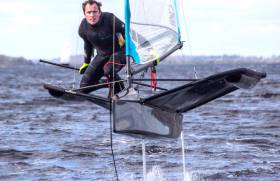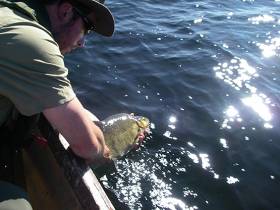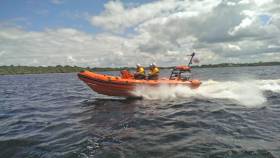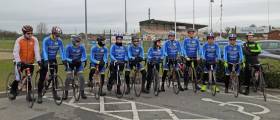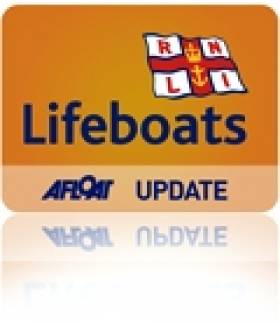Displaying items by tag: Lough Ree
With nine wins in ten races, Rory Fitzpatrick of the National Yacht Club is the undisputed king of the Irish Moth Tour 2016 following the weekend's Moth Inland Championships held on the inner lakes of Lough Ree.
Although Fitzpatrick, who finished on eight points after two discards, showed a clean pair of heels to the rest of the nine–boat fleet, Royal Cork's David Kenefick did well to take second on 21 points from Rio selected Annalise Murphy who finished five points behind in third overall.

Winner Rory Fitzpatrick in flying form on Lough Ree and below Annalise Murphy, both of the National Yacht Club. Photos: Courtesy Con Murphy
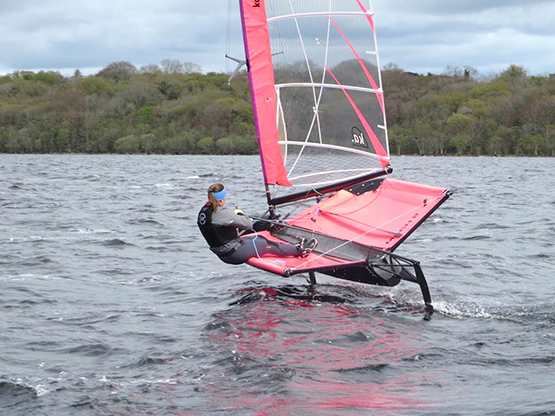
Full results are downloadable below.
The event was staged at the Wineport lodge hotel and the Moths were joined on the course by a ten boat Water Wag fleet (below) that featured a coaching session from UK sailing coach Mark Rhodes.

Inland Fisheries Ireland (IFI) has launched a report on a scientific survey of adult fish stocks in Lough Ree. The report details the findings of a fish stock assessment of the lake undertaken in 2014 to establish the status quo of all fish stocks, with particular reference to the brown trout population.
The assessment was the first time such a large scale extensive survey was undertaken on the lake. As part of the survey, brown trout genetic samples were collected and will feed into the greater Mid Shannon Brown Trout Genetics Study, currently underway in a partnership project between IFI and Queen’s University Belfast. The survey also provided valuable ecological information in relation to the status of invasive species such as zebra mussel (Dreissena polymorpha) and the Asian clam (Corbicula fluminea).
The survey, which was carried out over a two-week period in spring 2014, recorded eight fish species and a number of coarse fish hybrids. Roach were the dominant species with good numbers of roach/bream hybrids also noted. Other fish species present were perch, bream, pike, brown trout, rudd, pollan and tench. Pollan are a listed protected fish species on Annex V of the EU Habitats Directive and Lough Ree is only one of five lakes throughout the country that they are found in.
Dr Cathal Gallagher, Head of Research and Development at Inland Fisheries Ireland, said: “During the Lough Ree survey, eight fish species and a number of coarse fish hybrids were recorded. Almost 52 per cent of all fish noted during the survey were roach, 21 per cent roach/bream hybrids and 16 per cent were perch with significantly smaller numbers of bream, pike, trout, rudd and pollan making up the balance. The information provided from this survey will prove very useful in the context of conserving, managing and protecting such an important mixed stock fishery.”
Dr Ciaran Byrne, CEO of Inland Fisheries Ireland, commented: “Currently Lough Ree can be regarded as one of Ireland’s premier mixed fisheries. Mixed, in this instance, is a reference to three different fish stocks – cyprinid, pike and trout stocks. The status of all of these fish populations is such that, presently, each of them can provide quality angling on a seasonal basis.”
The Lough Ree survey report is available here
Two Callouts In 24 Hours For Lough Ree Lifeboat
#RNLI - The volunteer lifeboat crew with Lough Ree RNLI were called out twice in 24 hours to assist grounded vessels in the Wood Shoal area.
Thankfully there were no injuries any of those on board across both vessels, but the RNLI has advised marine users in the area to use caution and heed advice around submerged rocks.
The first callout came after midday on Tuesday (29 March) to reports of a cruiser with 10 people onboard grounded at Mouse Ear Rock.
When on scene, a lifeboat crew member boarded the vessel and assessed it for damage. There was a strong vibration from the engine and it was suspected that there may be damage to the propeller.
The lifeboat crew took the vessel under tow to Portrunney were it could be checked over for damage. The lifeboat was back on service shortly after 2pm with everyone safely ashore.
The second callout came the next day (Wednesday 30 March) at 3.35pm and was again to a grounded vessel, this time at Iskeraulin Shoal, south of Quaker. There were six people onboard with no reports of injuries.
On arriving on scene at 4.06pm, the lifeboat crew again assessed if there was any damage to the cruiser.
When it was confirmed that everything was working they helped the vessel free of the rocks and monitored its progress by travelling alongside it for a time. Once satisfied there was no further difficultym they departed the scene and returned to the station.
Commenting on the callouts, Lough Ree RNLI lifeboat operations manager Damien Delaney said: "Our volunteer lifeboat crew had a busy 24 hours. We would urge everyone using Lough Ree to ensure they are familiar with the area and to take heed of any warnings for rocks.
"Grounded vessels are not unusual but with any callout there are a number of factors that should be considered, such as weather and the right equipment. Make sure you have a suitable means of calling for help and that you have the proper clothing and a lifejacket. You never know when you will need to call for help."
Lough Ree was among the busiest of Ireland's lifeboat stations in 2015, recording the highest number of people assisted, as previously reported on Afloat.ie.
Fun & Fitness At Lough Ree RNLI Charity Cycle
#RNLI - Lough Ree RNLI’s third annual Lap Of Lough Ree charity cycle took place on Sunday 6 March, with 88 cyclists setting off in cold, dry weather at 10am.
The cycle started and finished at The Bounty, Buccaneers Rugby Club in Athlone and travelled north through Ballymahon, crossing the Shannon at Lanesborough, where refreshments were available courtesy of the Radisson Blu Hotel.
Cyclists then completed the 85km lap of Lough Ree in somewhat wetter conditions, travelling south on the Roscommon side, via Kilteevan, crossing the Shannon again at Athlone Bridge and returning to The Bounty for the finish.
Hot drinks were available at The Bounty for the returning cyclists, who reported that the going was a little slow for the first section but picked up pace nicely from Lanesborough.
Many of the attending cyclists are members of cycling clubs, and enjoy this event as a warm-up for the upcoming competitive cycling season.
Lough Ree RNLI treasurer Vincent Rafter said: "The cycle was a great success again this year and is becoming a firm fixture on the cycling calendar, as well as drawing casual cyclists from the area. There is a nice camaraderie among participants of all ability, and good fun was had along the way."
In other news, Lough Ree RNLI is currently seeking volunteers to join the lifeboat crew and shore crew.
This is a great opportunity to make a difference in your community, meet new people and use your skills to support the RNLI.
Boating experience and knowledge of Lough Ree are preferred but not essential. All training and kit is provided.
If you are interested and have the time to commit to this role, please contact Lough Ree RNLI lifeboat operations manager Damien Delaney at 087 2437092 for further information. The closing date for expression of interest is Monday 21 March.
Lough Ree Charity Cycle Returns To Raise Funds For Local Lifeboat
#RNLI - Lough Ree RNLI has announced its Lap of Lough Ree charity cycle will take place on Sunday 6 March.
As it has for the past two years, the cycle will start and finish at The Bounty at Buccaneers Rugby Club in Athlone, and will travel north through Ballymahon, cross the Shannon at Lanesboro Bridge and complete the 85km lap of Lough Ree travelling south on the Roscommon side, via Kilteevan, to cross again at Athlone Bridge.
Lough Ree RNLI relies entirely on public donations to fund its operation, and the Lap of Lough Ree is an important fundraising event for the charity organisation.
Lough Ree Lifeboat Station was the busiest station in Ireland in 2014 and rescued the highest number of people in 2015, so maintaining a high standard of service in the area is vital.
Brendan Finnegan, Lough Ree RNLI fundraising committee chairman, said: "We run a variety of events throughout the year to raise funds and we are privileged to have a huge level of support in the community.
"The cycle has proved very popular since we first organised it two years ago and it is a pleasure to run events that participants can get actively involved in. We are hoping for a big turnout again this year."
Registration for the event will take place from 9am on Sunday 6 March at The Bounty, with the cycle starting at 10am. Snack packs will be provided to all entrants and refreshments will be provided midway, at Lanesborough and also at The Bounty afterwards on return. Subject to numbers interested, an extended route may be arranged for cyclists who enjoy a more challenging ride.
The fee for entry is €25 on the day, but early entry is €20 via the Facebook entry form.
Lough Ree Lifeboat Assists Man Marooned On Shannon Barge
#RNLI - Lough Ree RNLI received their first callout of 2016 on Sunday 3 January when a man living aboard a barge was marooned by a strong river current on the River Shannon in Athlone.
The barge is moored below the old railway bridge in Athlone, where rising waters have covered the jetty, leaving the man on board surrounded by water and unable to safely reach the shore except by use of his tender dinghy.
The river was flowing fast at this location and the dinghy broke free. It was later retrieved downstream and tied up at a nearby location. However, the man on the barge was unable to reach it.
Lough Ree's lifeboat was paged at 2:35pm and made its way to the scene. Progress was hampered first at the motorway bridge, where the crew found the clearance greatly reduced, but they succeeded in passing through at low speed.
Progress towards the ‘White Bridge’ was slow because of the amount of debris in the water, and also because navigation markers were difficult to sight, being almost totally submerged.
Manoeuvring through the White Bridge required further care and skill, due to the speed of water flow and the narrowness of the navigable section of the bridge.
Lough Ree RNLI lifeboat helm Stan Bradbury said: "The river is moving very fast in Athlone at the moment, and contains debris of various sizes. Even shallow waters can be very dangerous under these conditions.
"We were glad to be of service in retrieving the tender and further securing the barge to its underwater moorings."
Flooding along the length of the Shannon remains a serious concern since heavy rains from December's winter storms saw the river breach its banks in a number of areas.
Lough Ree RNLI Receives €850 Raised At Athlone River Festival
#RNLI - Organisers of the Athlone River Festival and Food Village have presented a cheque for €850 to Lough Ree RNLI.
The Athlone River Festival & Food Village took place on 12-13 September and included myriad activities showcasing Athlone’s culinary, entertainment and leisure amenities.
The event was a huge success, with over 4,000 people attending the revival of the festival, last held 20 years ago.
Lough Ree RNLI and Athlone SubAqua took part in the event with a river rescue demonstration, and Lough Ree volunteer crew members also built a raft, which they entered in the raft race.
The ‘Oysters, Guinness & Jazz’ installation, sponsored by John O’Sullivan (Hodson Bay Group) and Alan McCabe (Guinness), set a celebratory tone for the event and raised €850 for the lifeboat, which they presented to the crew at the quay wall beside Sean’s Bar on 6 October.
Lough Ree RNLI relies entirely on charitable donations to meet its running costs. Damien Delaney, Lough Ree RNLI lifeboat operations manager, said: "It’s good supporters like John, Alan and the local community that enable the lifeboat crews to respond to calls when they are needed, and we are grateful for their generous support."
Lough Ree RNLI is also holding a Halloween Party and Open Day on Saturday 31 October from 12 noon to 3.30pm. Wear your costume and join the lifeboat crew for some Halloween fun and games for all at Coosan Point.
Lough Ree Lifeboat Tows Cruiser Off Rocks
#RNLI - Volunteers from Lough Ree RNLI were called to assist two people last Wednesday afternoon (30 September) after their motor cruiser ran aground on a shoal near Green Island on Lough Ree.
The crew was requested to launch their inshore lifeboat The Eric Rowse at 12.30pm following a report that the 42ft cruiser was aground west of Killinure Point.
Launching to the scene within minutes, the lifeboat crew found that no one was in any immediate danger and there was no damage to the boat.
Weather conditions at the time were described as bright with a Force 2 south-easterly gentle breeze and calm waters.
The crew set up a towline and moved the vessel into safe waters. Under their own power, the couple then proceeded towards Athlone.
Speaking following the rescue, lifeboat helm Tom Bradbury said: "There are a lot of shallow areas and rocky shoals on Lough Ree which can catch even the most experienced of sailors out.
"We would always encourage people taking to the lake to locate the next navigation marker every time you pass one as good practice and if you get into difficulty to request help as this couple sensibly did on this occasion."
Later that same afternoon, Ballycotton RNLI was launched to a kitesurfer who got into difficulty near Ballycotton Lighthouse.
The all-weather lifeboat and its volunteer crew was launched at 2.44pm in choppy seas with swells of up to two metres following a call from a nearby observer who spotted the kitesurfer in difficulty.
The kitesurfer was blown onto nearby rocks where they waited for assistance from the Ballycotton RNLI.
Speaking following the callout, coxswain Eolan Walsh said: "The kite surfer was lucky that a nearby observer spotted them in difficulty. We would always encourage anyone going on the water to carry a means of communication in case of emergency."
Lakelands Holiday Park Set To Put Longford On Tourism Map
#InlandWaters - An articificial lake will be the centrepiece of a new holiday retreat near Lough Ree, as The Irish Times reports.
Center Parcs' Longford Forest is set to go before planners next month, but the adventure village chain has already revealed its proposals for the 150-hectare site in Newcastle Wood near Ballymahon, Co Longford.
These comprise 500 chalets, including a number of treehouses, and amenities such as shops and restaurants situated around an artifical lake an an indoor "subtropical swimming centre".
The proposed location, owned by Coillte, is currently home to some 50 fallow deer that would have to be relocated to adjacent woodland during construction for the park, scheduled to open in 2019.
Meanwhile, Center Parcs says the vast majority of local people back its €100 million plans for Newcastle Wood, expected to boost significantly boost tourism to that corner of the Lakelands region.
And as Ronan McGreevy writes in The Irish Times, "it is hard to find anyone in Longford who is not enthusiastic about the prospect of Center Parcs coming to the county." More on the story HERE.
Galway Lifeboat Assists Teenager Stranded By Rising Tide
#RNLI - Clifden RNLI certainly had a busy weekend, but more recently in Galway a 19-year-old man was rescued from an island off Silver Strand yesterday evening (Wednesday 22 April) after he was stranded by the rising tide.
A kayaker spotted the teenager in distress in an area called Grey Rock, east of Silver Strand near Barna at approximately 7.45pm, and contacted the emergency services.
Volunteers from Galway RNLI launched their inshore lifeboat from Galway Docks at 8.01pm and arrived at the area within nine minutes.
Two members of the lifeboat crew made their way onto the island and tended to the young man. They were joined in the rescue operation by Galway Garda and members of the Irish Coast Guard from Rosaveel.
The coastguard vessel took the young man and a Garda onboard and transferred them both onto the RNLI lifeboat which ferried them to Galway Docks.
- The casualty was medically examined by a lifeboat crew member at the lifeboat station at about 9.30pm. He was then transferred by ambulance to University Hospital Galway.
The lifeboat crew on this call out were helm Dara Oliver, Kieran Tolan, Daniel King and Alice Miller, and two shore crew, Olivia Byrne and Sean King. Two gardaí and five coastguard crew were also at the shore.
Elsewhere, the Lough Ree RNLI lifeboat crew received their first callout of 2015 on Saturday 18 April after a 37-foot hire cruiser ran aground on Wood Shoal, near Lecarrow.
The cruiser, which went astray of the navigation channel in mild conditions and failing light, contacted the coastguard, who then requested Lough Ree RNLI to launch at 9.22pm.
The Eric Rowse lifeboat was launched at 9.28pm and reached the grounded vessel in 20 minutes. After checking that the seven crew on board were safe and well, the boat was checked for hull damage and then towed off the rocks.
The vessel was not holed but the rudder was damaged, making steering impossible. The lifeboat crew towed the cruiser to safe moorings in Lecarrow before returning to the station.



























